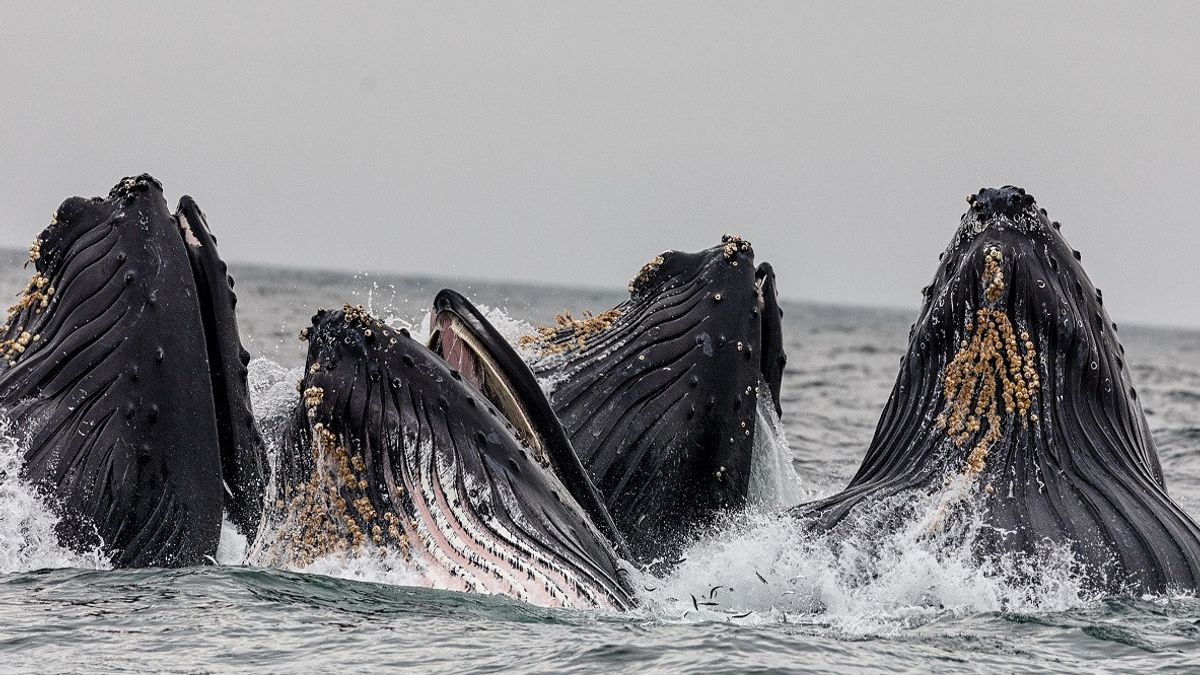JAKARTA - The first study to methodically quantify how much food the blue whale and some of its close relatives eat has yielded a simple answer: a lot.
Blue whales, the largest animals in Earth's history, eat about 16 tonnes of krill daily in the North Pacific, devouring these tiny shrimp-like crustaceans with a filter-feeding system in their mouths using baleen plates made of keratin, a substance found in human fingernails, scientists say. scientists on Wednesday.
"That's about the weight of a fully loaded school bus," said study co-author Nick Pyenson, curator of marine mammal fossils at the Smithsonian Institution's National Museum of Natural History in Washington.
The researchers calculated daily food intake for seven species of baleen whales, tracking 321 individual whales in the Atlantic, Pacific and Southern Oceans from 2010 to 2019.
These giant marine mammals were found to eat up to three times more than previously thought, based on the guts of whales being hunted or extrapolation from smaller marine mammals.
Other species studied, humpback, fin, bowhead, right, Antarctic minke to Bryde's whale, also devour impressive numbers. The North Pacific Humpback Whale can eat 9 tonnes of krill daily, while the fin whale consumes 8 tonnes.

"This is an unimaginable amount of food. But the huge whale itself is unimaginable. A blue whale the size and weight of a Boeing 737," said Stanford University marine biologist Matthew Savoca, lead author of the study published in the journal Nature.
To note, the blue whale was even bigger than the largest dinosaur, reaching a length of 110 feet (33 meters) and 200 tons.
The researchers determined how often each whale engaged in feeding behavior using electronic tagging devices placed on the animals' backs, with cameras, microphones, GPS locators and instruments that track movement. Drones are used to estimate the size of the whale's mouth area and how much prey it can swallow. The acoustic method measures the biomass of nearby prey.
Baleen whales feed on zooplankton, small prey including krill, fish or crustaceans called copepods. The largest species prefer krill. Smaller species such as the humpback whale, Bryde or minke may eat school fish or krill.
Most baleen whales do not eat all year round, having annual cycles of feasting or starvation. They eat about 100 days each year, usually during the summer mating season, while eating little the rest of the year. Based on eating 16 tonnes a day, a blue whale would consume perhaps 1,600 tonnes per year.

Food intake varies by species, location and type of prey. Among the three humpback populations studied, North Pacific krill specialists consumed 9 tonnes daily, North Pacific fish-eaters 3.5 tonnes, and Southern Ocean krill specialists 3 tonnes daily.
Among other species, Arctic bowhead whales consume 6 tonnes of copepods daily, North Atlantic right whales 5 tonnes of copepods, 1 tonne of South Atlantic Bryde fish, and Southern Ocean minke 0.69 tonnes of krill.
Because whales eat more than previously known, they also produce more excrement, an important source of marine nutrients. By capturing prey and defecating, they help keep nutrients suspended near the ocean's surface to produce carbon-absorbing microscopic organisms called phytoplankton that form the basis of the marine food web.
Pyenson said the study's calculations showed that before the numbers of baleen whales were dramatically reduced by 20th century industrial whaling, they had consumed more food than all of the world's krill biomass today and global fisheries combined.
"The implication of these figures is that whales supported marine ecosystems that were much more productive prior to whaling, and that promoting whale recovery in the 21st century could restore ecosystem function lost in the last hundred years," Pyenson said.
The English, Chinese, Japanese, Arabic, and French versions are automatically generated by the AI. So there may still be inaccuracies in translating, please always see Indonesian as our main language. (system supported by DigitalSiber.id)













